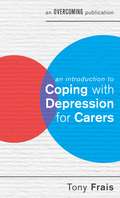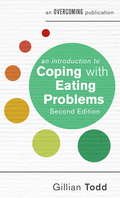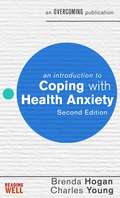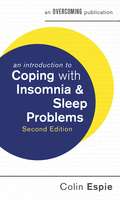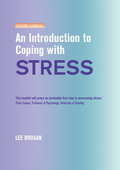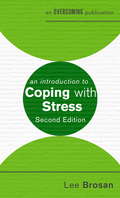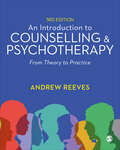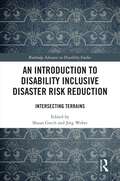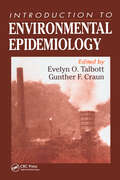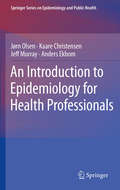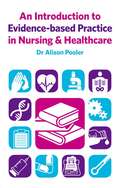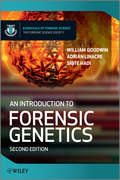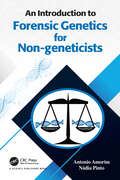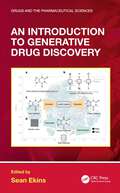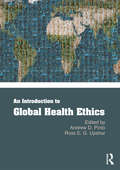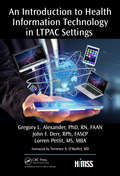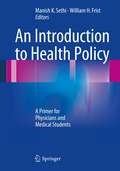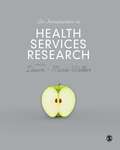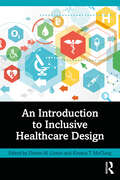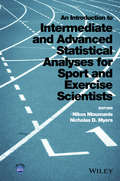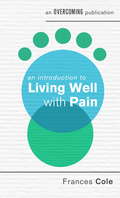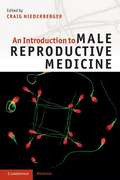- Table View
- List View
An Introduction to Coping with Depression for Carers (An Introduction to Coping series)
by Tony FraisAn indispensable guide offering insight and support to carers of people with depressionLooking after a person with depression can often leave carers emotionally and physically exhausted. This short, straightforward and easily understandable guide offers valuable advice on how carers can:- better understand the nature of depression and how it affects both patient and carer- have a clearer understanding of the treatment options for the patient, including medication and therapy- lessen the impact of the illness on the carer's life- find the help and support they need- maintain their own well-being whilst supporting the patient through to recovery and beyondAlthough aimed at the carer, this is a guide that is equally valuable to the patient themselves and to their wider family and friends in promoting a better understanding of the experience of depression.
An Introduction to Coping with Eating Problems, 2nd Edition (An Introduction to Coping series)
by Gillian ToddEating problems, including anorexia nervosa and bulimia nervosa, can have a devastating impact on sufferers as well as their friends and family. This self-help guide is written by a consultant psychotherapist with extensive experience of treating eating disorders and will help you identify an eating disorder and develop a toolkit of strategies to help you take steps towards overcoming the disorder. It also includes a chapter offering useful guidance for family members.This updated second edition will help you:· Understand how eating disorders develop and what keeps them going· Find the motivation to change · Change how you eat· Challenge negative thinkingThe Introduction to Coping series offers valuable guidance for those seeking help for emotional or psychological problems such as depression and anxiety. Each book gives useful background information and suggests techniques to change unhelpful patterns of behaviour and thinking using cognitive behavioural therapy (CBT) techniques. CBT is recommended internationally to treat a wide range of emotional, psychological and physical conditions including eating disorders.
An Introduction to Coping with Grief, 2nd Edition (An Introduction to Coping series)
by Sue MorrisGrief is a natural reaction to loss but in some cases it can be devastating, preventing you from moving on in your life and affecting your relationships and work. This fully updated self-help guide offers an examination and explanation of the grieving process and outlines clinically-proven strategies, based on cognitive behavioural therapy (CBT), to help you adjust to life without a loved one:· Knowing what to expect when you are grieving· Understanding the physical and psychological reactions to grief· Practical coping strategies to help you deal with your loss
An Introduction to Coping with Health Anxiety, 2nd edition (An Introduction to Coping series)
by Brenda Hogan prof Charles YoungLearn how to control your health anxietyHealth anxiety affects many people across the world - a preoccupation with physical illness that is equally bad for your mental health. This can be worsened in times of global panic about pandemics. This self-help guide explains how health anxiety develops and what keeps it going. This updated edition gives you clinically proven cognitive behavioural therapy (CBT) techniques to help you challenge the way you think and behave, such as:- What health anxiety is and how it develops - Physical symptom - How to spot and challenge thoughts that make you anxious. - Reducing your focus on illness- How to spot and challenge thoughts that make you anxious- Reducing your focus on your body and on illness
An Introduction to Coping with Insomnia and Sleep Problems, 2nd Edition (An Introduction to Coping series)
by Colin EspiePoor sleep can have a huge impact on our health and wellbeing, leaving us feeling run-down, exhausted and stressed out. This self-help guide explains the causes of insomnia and why it is so difficult to break bad habits. This updated edition gives you clinically proven cognitive behavioural therapy (CBT) techniques for improving the quality of your sleep:· Keeping a sleep diary· Setting personal goals· Improving your sleep hygiene· Dealing with a racing mind· Making lasting improvements to your sleeping and waking pattern
An Introduction to Coping with Stress
by Leonora BrosanOvercoming app now available.This is a new addition to the popular 'Introduction to Coping with' series of self-help booklets. Written by the author of the popular self-help title Overcoming Stress, An Introduction to Coping with Stress offers a first step in CBT-based self-help. We all know what stress feels like, and indeed what it feels like when we have too much stress in our lives. Too much stress can have a negative impact on us, almost without our noticing it. It can affect our family life, friendships and other relationships, our work life and our physical and emotional wellbeing. This self-help guide uses CBT strategies to help the reader to recognise what happens to us when we are under stress and how we can change how we feel, think and act in order to regain a more balanced outlook on life and manage it more effectively. This practical booklet is also an ideal resource for health professionals and carers.
An Introduction to Coping with Stress, 2nd Edition (An Introduction to Coping series)
by Leonora BrosanA revised and updated edition in the popular 'Introduction to Coping with' series of self-help books. Written by the author of the popular self-help title Overcoming Stress, An Introduction to Coping with Stress 2nd Edition offers a first step in self-help, using techniques from cognitive behavioural therapy (CBT). We all know what stress feels like, and indeed what it feels like when we have too much stress in our lives. Too much stress can have a negative impact on us, almost without our noticing it. It can affect our family life, friendships and other relationships, our work life and our physical and emotional wellbeing. This self-help guide uses CBT strategies to help the reader to recognise what happens to us when we are under stress and how we can change how we feel, think and act in order to regain a more balanced outlook on life and manage it more effectively. This practical booklet is also an ideal resource for health professionals and carers.
An Introduction to Counselling and Psychotherapy: From Theory to Practice
by Andrew ReevesThis latest edition introduces you to the fundamentals of counselling and psychotherapy, accompanied by fresh research, perspectives and case-studies - ensuring comprehensive and up-to-date coverage of the context, theories, skills and practice of counselling professions. This book also covers the latest developments in the world of counselling and psychotherapy, including: -Online counselling and psychotherapy -Social justice approaches and the political positioning of therapy -Updated content and reading lists addressing diversity, inclusivity and decolonisation. The Introduction is designed to support and expand your learning and development, with features such as discussion questions, prompts for reflection, case examples and further reading. Beyond the pages of the book, there is a complementary set of extensive online resources, including further case studies, journal articles and videos. From newly enrolled to starting your practice placement, this book is the perfect companion for your counselling training, and beyond.
An Introduction to Counselling and Psychotherapy: From Theory to Practice
by Andrew ReevesThis latest edition introduces you to the fundamentals of counselling and psychotherapy, accompanied by fresh research, perspectives and case-studies - ensuring comprehensive and up-to-date coverage of the context, theories, skills and practice of counselling professions. This book also covers the latest developments in the world of counselling and psychotherapy, including: -Online counselling and psychotherapy -Social justice approaches and the political positioning of therapy -Updated content and reading lists addressing diversity, inclusivity and decolonisation. The Introduction is designed to support and expand your learning and development, with features such as discussion questions, prompts for reflection, case examples and further reading. Beyond the pages of the book, there is a complementary set of extensive online resources, including further case studies, journal articles and videos. From newly enrolled to starting your practice placement, this book is the perfect companion for your counselling training, and beyond.
An Introduction to Disability Inclusive Disaster Risk Reduction: Intersecting Terrains (Routledge Advances in Disability Studies)
by Shaun Grech Jörg WeberThis first of its kind volume introduces Disability Inclusive Disaster Risk Reduction (DIDRR) in unprecedented critical and interdisciplinary ways covering the complex conceptual, theoretical and practice terrain. Established and emerging scholars and practitioners introduce and probe key discourses, theory, policy and practice at the intersections of disability, disasters and disaster risk reduction, navigating compound and dynamic areas including climate change, governance, wars and conflict, forced migration, disability representation, geopolitics, gender and ethnicity. This edited book lays out and questions established policies, discourses and practices in mainstream areas including Disaster Risk Reduction, Disaster Risk Management and Humanitarian Action, opening an effective critical debate to understand, challenge and shift dominant paradigms. By developing new theory on DIDRR, it will serve as an important tool for academics, researchers and practitioners working in multiple fields including disability studies, disaster management, global health, humanitarian studies, international studies and geography among others.
An Introduction to Environmental Epidemiology
by Gunther F. Craun Evelyn O. TalbottAn Introduction to Environmental Epidemiology covers the basics of environmental exposure, health, and disease. Written to be easily accessible to readers with no formal training in epidemiology or statistics, this practical introduction is an ideal text/reference for students and professionals in nursing, medicine, industrial hygiene, occupational and environmental health, and general environmental science. It provides a target-organ oriented presentation of environmental hazards, with detailed discussions of selected exposures such as asbestos, lead, radon, and indoor and outdoor air pollutants. Major topics covered include:
An Introduction to Epidemiology for Health Professionals (Springer Series on Epidemiology and Public Health #1)
by Anders Ekbom Jørn Olsen Kaare Christensen Jeff MurrayToday, the public worries about emerging diseases and rapid changes of the frequency of well known diseases like autism, diabetes and obesity making the word epidemic part of the general discussion. Epidemiology should therefore be a basic component of medical training, yet often it is undertaught or even neglected. Concise and readable while also rigorous and thorough, An Introduction to Epidemiology for Health Professionals goes beyond standard textbook content to ground the reader in scientific methods most relevant to the current health landscape and the evolution of evidence-based medicine--valuable keys to better understanding of disease process, effective prevention, and targeted treatment.
An Introduction to Evidence-based Practice in Nursing & Healthcare
by Alison PoolerThe beginner's guide to Evidence-based Practice for Nursing, Health and Social Care.An Introduction to Evidence-based Practice in Nursing & Health aims to help students, educators, mentors and professionals to make sense of knowledge derived from research and how to use it as a basis for making sound decisions about patient care. Covering everything from basic terminology to the application of Evidence-based Practice in your everyday routine, this text is the guide to better practice.Written in a accessible and interactive style, An Introduction to Evidence-based Practice in Nursing & Health clearly sets out what Evidence-based Practice is, why it is important and how you can use it successfully to improve patient care.Key Features for success in Evidence-based Practice:Simply and quickly shows you what Evidence-based Practice is and how you can use it. Helps you to develop an understanding of the policies driving Evidence-based Practice and professional development. Regular reinforcement of your learning through integrated Activities and end-of-chapter self assessment. Extensive references and suggestions for further reading and online research. Integrated Glossary keeps you up-to-date with the latest jargon.
An Introduction to Forensic Genetics
by Adrian Linacre William Goodwin Sibte HadiThis is a completely revised edition of a comprehensive and popular introduction to the fast moving area of Forensic Genetics. The text begins with key concepts needed to fully appreciate the subject and moves on to examine the latest developments in the field. Now illustrated in full colour throughout, this accessible textbook includes numerous references to relevant casework. With information on the full process of DNA evidence from collection at the scene of a crime to presentation in a legal context this book provides a complete overview of the field.Key Features:Greater in-depth coverage of kinship problems now covered in two separate chapters: one dealing with relationships between living individuals and the other covering identification of human remains. New chapter on non-human forensic genetics, including identification of bacteria and viruses, animals and plants. Self assessment questions to aid student understanding throughout the text. Now with full colour illustrations throughout New companion website Accessible introduction to forensic genetics, from the collection of evidence to the presentation of evidence in a legal context. Included in the Forensic Science Society 'Essentials in Forensic Science' book series. This edition is to be included in the Forensic Science Society 'Essentials of Forensic Science' book series aimed at advanced level undergraduates and new practitioners to the field.
An Introduction to Forensic Genetics for Non-geneticists
by Antonio Amorim Nádia PintoThis book aims to enable non-experts in Genetics to understand the contribution of this science to resolve civil or criminal litigations, analysing evidence of human and non-human origins. The main difficulties in the comprehension and misuse of the results of Forensic Genetics reside in the lack of effective communication between geneticists and the users of the produced information (as lawyers and judges) and do not arise primarily from the lack of knowledge of genetics. Therefore, instead of a classical handbook we use a question-and-answer approach, which meets this interfacial essence. Questions that can be addressed by genetic expertise are typified and for each of them we provide the possible expert report, presenting the essential biological and statistical genetics background in the form of boxes/appendices, along with exemplary cases. Legal, ethical, and theoretical limitations of Forensic Genetics are discussed, formulating questions that cannot, or should not, be addressed by this applied science.
An Introduction to Generative Drug Discovery (Drugs and the Pharmaceutical Sciences)
by Sean EkinsThis book focuses on the latest advances in computational de novo drug discovery methods, also known as generative drug discovery. This book describes the state‑of‑the‑art methods and applications for de novo design of drug candidates using generative chemistry models as well as the ethical aspects of this technology. It will provide a foundation for those new to the field as well as those that may already have some experience of its utility. With contributions from scientists in both academia and industry ‘an Introduction to Generative Drug Discovery’ may represent one of the earliest if not the first book to focus on this topic. This book focuses on the latest advances in generative discovery methods. This book will describe different state of the art applications of generative molecule design. The book describes ethical aspects of generative drug discovery technology. The mix of academic and industrial authors provides an array of applications of generative drug discovery. A future perspective of where these generative technologies may take us in drug discovery is described included self-driving labs.
An Introduction to Global Health Ethics
by Andrew D. Pinto Ross E. UpshurThe field of global health is expanding rapidly. An increasing number of trainees are studying and working with marginalized populations, often within low and middle-income countries. Such endeavours are beset by ethical dilemmas: mitigating power differentials, addressing cultural differences in how health and illness are viewed, and obtaining individual and community consent in research. This introductory textbook supports students to understand and work through key areas of concern, assisting them in moving towards a more critical view of global health practise. Divided into two sections covering the theory and practice of global health ethics, the text begins by looking at definitions of global health and the field’s historical context. It draws on anti-colonial perspectives concepts, developing social justice and solidarity as key principles to guide students. The second part focuses on ethical challenges students may face in clinical experiences or research. Topics such as working with indigenous communities, the politics of global health governance, and the ethical challenges of advocacy are explored using a case study approach. An Introduction to Global Health Ethics includes recommended resources and further readings, and is ideal for students from a range of disciplines – including public health, medicine, nursing, law and development studies – who are undertaking undergraduate and graduate courses in ethics or placements overseas.
An Introduction to Health Information Technology in LTPAC Settings (HIMSS Book Series)
by Gregory L. Alexander, PhD, RN, FAAN Derr F. John, RPh, FASCP Lorren Pettit, MS, MBAA multiplicity of factors converging together suggest the long term/post-acute care (LTPAC) provider community (e.g. nursing homes, behavioral health facilities, home health agencies, etc.) will accelerate in importance within the healthcare ecosystem during the next few years. The challenge for many LTPAC providers in this emerging environment will be to advance their clinical health information technologies (health IT) capabilities in order to "play" with other providers in the healthcare "sandbox." This book is designed to assist LTPAC leaders in identifying and exploring the array of critical issues one needs to consider in order to operate within an advanced clinical health IT ecosystem. This book surveys key issues surrounding the use of clinical health IT in LTPAC settings, to include providing readers with a suggested strategic plan and roadmap for selecting and installing digital health technologies in LTPAC organizations. Though the focus of the book primarily centers on the U.S. LTPAC provider’s experience, the authors also spend time addressing global and future LTPAC considerations.
An Introduction to Health Policy: A Primer for Physicians and Medical Students
by William H. Frist Manish K. SethiBased on the current climate of our nation's finances and healthcare spending, it is clear that young doctors and medical students are likely to see a dramatic transformation of the manner in which America offers medical care to its citizens over the course of their careers. As such, it is pivotal that the next generation of America's leaders on the front lines of medicine develop a sense of where healthcare has evolved from and future potential directions of change. An Introduction to Health Policy: A Primer for Physicians and Medical Students is the first of its kind: a book written by doctors for doctors in order to allow busy physicians and medical students to quickly develop an understanding of the key issues facing American healthcare. This book seeks to efficiently and effectively educate physicians and medical students in a clinical context that they can understand on the past, present, and potential future issues in healthcare policy and the evolution of American healthcare. The reader will walk away from the book with the ability to discuss the fundamental issues in American healthcare with ease.
An Introduction to Health Services Research: A Practical Guide
by Dawn-Marie WalkerThis is a primary, comprehensive textbook for people who are considering undertaking a piece of health-related research. It is an accessible companion with the aim of getting the reader to think broadly about all of the issues that need to be considered when embarking on a project. This is a pragmatic book, a step-by-step guide to research which mirrors the structure of a research project, taking you through the thought process for designing and conducting your study from formulating the right research question at idea inception, ascertaining what methodologies and analysis can answer what type of questions, right through to dissemination, all presented in an easy, digestible style. The book is full of case study illustrations and practical tips such as how to work out a research budget and obtaining funding for your project, discussion of what permissions need to obtained when conducting research with people, and how to involve public and patients. The authors are all experienced researchers and so this book is an accumulation of collective wisdom on common research challenges and issues.
An Introduction to Humanitarian Action (Routledge Humanitarian Studies)
by Kristina Roepstorff Katrin RadtkeThis important new textbook provides a concise and practice-oriented introduction to the workings of the humanitarian sector and the key contemporary debates surrounding it.The number of people around the world in need of humanitarian action and protection is at its highest figure in decades; yet at the same time, the humanitarian system is facing numerous problems and undergoing fundamental reforms. This book invites us to tackle these challenges head on, addressing the increasing complexity of humanitarian crises and the implications for humanitarian principles and standards as well as the management of humanitarian projects. Expansive in scope, the book covers: The sector’s historical foundations and the need to decolonise The main types of crises and sectors of humanitarian response State and non-state actors and institutions The key rules, norms, and project management approaches Key trends and challenges, including access, innovation, and anticipation The book also covers important debates on localisation, inclusive programming, and the decolonisation of the humanitarian system. This exciting new textbook will be an important read for students looking for a comprehensive introduction, as well as for practitioners wanting to stimulate critical thinking and enhance their practical skills.
An Introduction to Inclusive Healthcare Design
by Denise M. Linton Kiwana T. McClungAn Introduction to Inclusive Healthcare Design is a comprehensive guide to the design and facilitation of safe, healthy, equitable, and inclusive healthcare settings across a variety of scales. The book informs healthcare professionals, healthcare administrators, planners, designers in the healthcare sector, design students, and faculty about best practices and considerations for inclusive design.The primary theme for the book is design for all – considering the design of healthcare spaces through the lenses of inclusivity and social equity. Part 1 presents the reader with an overview of the variety of locations and types of healthcare settings. Part 2 provides a comprehensive overview of the principles of equitable and inclusive healthcare design and considers how these principles can be applied to the range of settings laid out in Part 1. The authors consider inclusivity-supportive infrastructure in primary and ancillary spaces within healthcare settings. Part 3 envisions the future of inclusive healthcare design, considering the integration of virtual reality and artificial intelligence, as well as addressing the ever more relevant issue of healthcare provision in settings at risk of natural disasters.
An Introduction to Intermediate and Advanced Statistical Analyses for Sport and Exercise Scientists
by Nicholas D. Myers Nikos NtoumanisNtoumanis and Myers have done sport and exercise science researchers and students a tremendous service in producing An Introduction to Intermediate and Advanced Statistical Analyses for Sport and Exercise Scientists. This book has an outstanding compilation of comprehensible chapters dealing with the important concepts and technical minutia of the statistical analyses that sport and exercise science scholars use (or should be using!) in their efforts to conduct meaningful research in the field. It is a resource that all sport and exercise scientists and their students should have on their book shelves. Robert Eklund, School of Sport, University of Stirling, UK Motivating, to have a statistics text devoted to enabling researchers studying sport and exercise science to apply the most sophisticated analytical techniques to their data. Authors hit the mark between using technical language as necessary and user-friendly terms or translations to keep users encouraged. Text covers traditional and well-used tools but also less common and more complex tools, but always with familiar examples to make their explanations come alive. As a dynamic systems theorist and developmentalist, I would love to see more researchers in my area create study designs that would enable the use of tools outlined here, such as multilevel structural equation modeling (MSEM) or mediation & moderation analyses, to uncover cascades of relations among subsystems contributing to motor performance, over time. This text can facilitate that outcome. Beverly D. Ulrich, School of Kinesiology, University of Michigan, USA The domain of quantitative methods is constantly evolving and expanding. This means that there is tremendous pressure on researchers to stay current, both in terms of best practices and improvements in more traditional methods as well as increasingly complex new methods. With this volume Ntoumanis and Myers present a nice cross-section of both, helping sport and exercise science researchers to address old questions in better ways, and, even more excitingly, to address new questions entirely. I have no doubt that this volume will quickly become a lovingly dog-eared companion for students and researchers, helping them to continue to move the field forward. Gregory R. Hancock, University of Maryland and Center for Integrated Latent Variable Research (CILVR), USA
An Introduction to Living Well with Pain (An Introduction to Coping series)
by Dr. Frances ColePractical 'footsteps' to help you live well with a chronic pain conditionIf you live with a long term condition that causes you chronic pain, then you are not alone. Chronic or persistent pain affects many adults and children in many ways. It can impact on your mood, your home and work life, your relationships, your sleep, your activities and all areas of your health. It can take your life over. Change is possible. Effective pain management requires a practical multi-focused approach. This self-help guide brings together tools that have worked with thousands of people with pain. It guides you through skills that help you stop struggling and cope well with pain, including:· Goal-setting, making action plans and rewarding yourself· Pacing your day to day activities and building in relaxation practice· Developing healthy exercise and eating routines· Sleeping well again· Coping with setbacks
An Introduction to Male Reproductive Medicine
by Craig NiederbergerAn Introduction to Male Reproductive Medicine is written specifically for readers seeking entry into this fast-moving, complex specialty with a solid understanding of the subject. The first chapters cover the anatomy and physiology, clinical evaluation, surgery, medicine, genetics and laboratory testing involved in the current evaluation and treatment of the infertile male, and the final chapter describes the interaction of the field with female reproductive medicine. Throughout the book, references are directly made to the fourth edition of the major text in the specialty, Infertility in the Male, edited by Larry Lipshultz, Stuart Howards and Craig Niederberger, allowing readers to expand their understanding of specific areas where desired. Each chapter is written by a well-renowned expert in an easy to follow, informal style, making the text ideal for students, residents and general physicians who are seeking to increase their general knowledge of the field.
